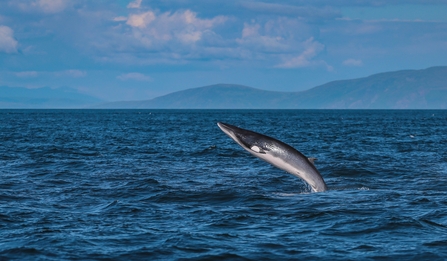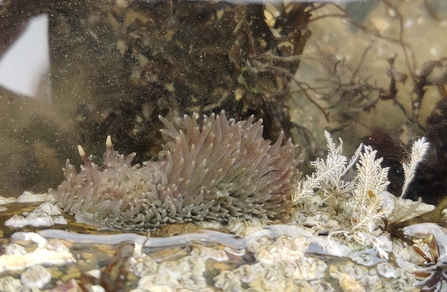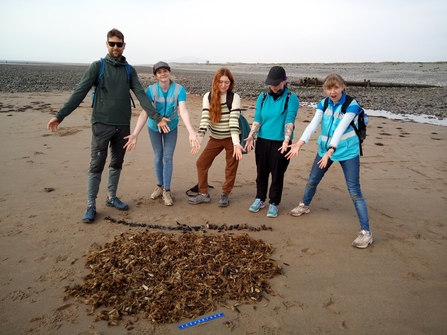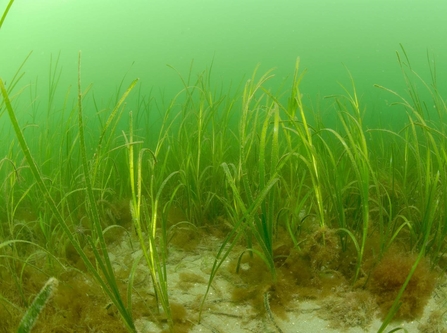
Unusually, there were two sightings of a minke whale off Cumbria in 2022 © Tom McDonnell
Gifting membership? Order by Wednesday 17 December in time for Christmas.

Unusually, there were two sightings of a minke whale off Cumbria in 2022 © Tom McDonnell
From a nine-metre-long whale to tiny, jelly-like sea gooseberries about the size of a 5p, the Irish Sea coast off Cumbria is home to a huge variety of amazing wildlife, that comes in all shapes and sizes. Our marine team, with other North West Wildlife Trusts, is working hard to protect wildlife and habitats in the Irish Sea, and to bring people closer to nature on the coast. Here we share some of our memorable marine moments, both highs and lows, and some surprising sea sightings of 2022.
The minke is the UK's smallest whale. Unusually for Cumbria, one was spotted off the coast of Walney in April and then again near Workington in September. They’re more often spotted around Scotland during the summer months. They’re known to be curious around boats and can even breach clear of the water. Beware though: their ‘fragrant’ breath has given them the nickname Stinky Minkes! Minke whale sounds can be as loud as 150 decibels - that’s the same as a jet plane taking off! This allows them to communicate over long distances underwater.
Spotting dolphins off our coastline is always an exciting moment, and this year a walker spotted a pod of eight dolphins and porpoises at St Bees Head and reported it to one of our volunteers. While not unusual, this sighting was earlier in the year than expected, in May. If you fancy a bit of dolphin and porpoise-spotting, there’ll be more opportunities to get involved with sea watch surveys next year – keep an eye on our online events listing.
Last year one of our highlights was seeing a ‘scarlet lady’ - a bright pink sea slug. This year we recorded the rather more boring-sounding grey sea slug, but we were no less excited! While it may not have the vibrant colour of the scarlet lady, this was a very rare sighting for Cumbria, and was found in a rock pool at Earnse Bay on Walney. These slugs can be up to 12cm long, are usually grey or brown and covered in lots of floppy projections. They’re not only able to eat sea anemones without getting stung, but can actually reproduce the anemone’s stinging cells into their own body for protection!

A rare grey sea slug was recorded at Earnse Bay © Holly Stainton
Mass strandings of marine life are not uncommon and in May, thousands of sea gooseberries washed up on the beach in Barrow after high winds. They’re small oval or round, jelly-like blobs, which aren’t true jellyfish but ‘ctenophores’, and also known as comb jellies.
Georgia de Jong Cleyndert, Senior Marine Conservation Officer at Cumbria Wildlife Trust said: “The question we get asked most often about sea gooseberries is ‘Do they sting?’! The simple answer is no! These delicate, jelly-like creatures are not actually true jellyfish, so they don’t have stinging cells. They are pretty common in summer. They feed on plankton and other small animals and will mostly follow the migration of their prey. A big stranding like this usually means that there was lots of food available at the surface and then high winds brought them into shore.”
A worm pipefish was seen at Earnse Bay, also not normally spotted this far north. Very easy to mistake for a piece of seaweed or a twig if you find one stranded under a rock, it usually has a dark olive, glistening body. They can grow up to 15cm long but are only about a centimetre thick! Look for an upturned seahorse-type snout and beautiful light green markings around the eyes and face.
Another ‘first’ this year was the discovery of a nest of 20 juvenile broad-clawed porcelain crabs under rocks at St Bees beach, the first time they’ve ever been recorded here. It was also the biggest number of this species we’ve ever spotted on one survey. You have to look closely for them though, they're pretty well camouflaged! It’s a small brown crab, covered in tiny hairs with large, flattened hairy claws.
Georgia said: “Porcelain crabs are fragile animals and will shed a leg if attacked, in the same way that a lizard sheds its tail. It's this fragility that gives them their name! It’s worth reminding anyone who is out rockpooling, looking for some of these amazing creatures, to be careful to leave everything as you found it - replace any rocks you turn over, put back any crabs or fish and ensure you don’t scrape anything off its rocky home.”
In April, a group of shore-searchers took part in an Easter egg hunt at Walney, looking not for chocolate eggs but for egg cases (also known as mermaid’s purses) discarded by sharks and rays. They found no less than 3,316, a huge number in one search! This included 3,254 cases from small spotted catsharks, 19 from nursehound sharks, 34 from thornback ray, three from cuckoo ray and six from spotted ray. Did you know we had such a variety of sharks and rays just off the coast here in Cumbria?!
Shark and ray egg-case hunts are just one of the community activities you can do on the coast with The Bay, a joint Nature and Wellbeing Programme we’re involved with in Morecambe Bay - keep an eye on The Bay website. In just one year the project has enticed over 5,300 people to marine events and over 200 people have been referred by health care providers or by themselves to enjoy the coast to improve their mental health.

3,316 shark and ray egg cases were found at an Easter egg hunt at Walney © Sophie Smith
One of our big nature recovery stories of the year was helping populations of herring and lesser black-backed gulls to bounce back. Thanks to the installation of predator-proof fencing, the number of gulls nesting and fledging at our South Walney Nature Reserve has risen by 150% in two years. This recovery was welcome after numbers had dwindled to a few hundred pairs in 2020, putting the colony in danger of vanishing completely.
Another great step forward for marine conservation this year was Allonby Bay on the Solway Firth being put forward as a Highly Protected Marine Area (HPMA) by Defra, after years of campaigning by Cumbria Wildlife Trust, our members and supporters. Georgia explains why this new status would be so important: “Despite all the amazing wildlife we’ve seen this year, our seas are under pressure like never before; decades of over exploitation, pollution and unchecked development have resulted in continued biodiversity loss and a degradation of the marine habitats. In theory HPMAs will ban all extractive and damaging activities, such as taking anything out of the sea or coast, or building anything in the area. This would mean no activities such as fishing, angling, anchoring or cabling.
“The new status would protect large areas of blue mussels and the best example of honeycomb worm reefs in the UK, which provide habitat for a wealth of different species. This area is also an important spawning and nursery ground for plaice, skate and thornback rays, and is a pupping ground for harbour porpoise. We will hear more in the New Year about the outcome of the consultation and whether the proposal goes ahead.”
In July the marine team made an important and exciting discovery: a new, un-surveyed bed of sea grass in the Ravenglass estuary. Georgia explains why it is so important: “Seagrass, which looks just like grass in your garden, is brilliant at capturing carbon. In fact it does this 35 times faster than tropical rainforests - known as blue carbon capture - so it’s one of our most important natural solutions to the climate change crisis.
“Back in 2013, a 1m2 patch of seagrass in the Ravenglass estuary was reported, though the area wasn’t thoroughly surveyed. This year we went back to do a more in-depth survey and were really pleased to record over 1697m2 of patches of seagrass in the area. Here in the UK we’ve lost around 90% of our seagrass meadows, half of this has been in the past three decades. This is why we’re calling for nature’s recovery at sea, not just on land. We need to keep monitoring this precious carbon-capturing species and ensure that it’s protected, as this natural solution can help us fight the climate crisis.”
Finally, another major milestone this year was the launch of the Irish Sea Network’s ‘Review of the Irish Sea 2022’ and its vision and position statements. The Irish Sea is under significant and increasing pressure from climate change and activities like fishing, aquaculture (the farming of fish, shrimps, seaweed and molluscs), development, shipping, aggregates, military activity, recreational activity and pollution. The Irish Sea Network highlights the need to work together to protect the Irish Sea.

1,697m2 of patches of seagrass were recorded at Ravenglass © Paul Naylor